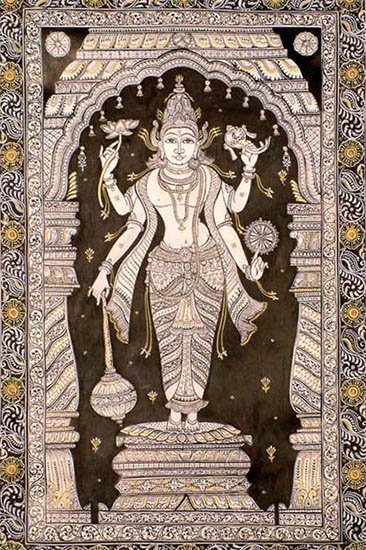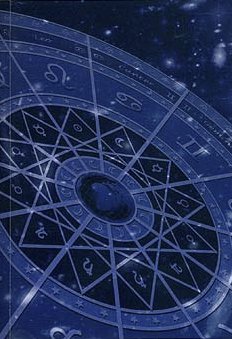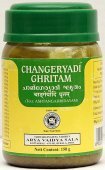Ambu, Aṃbu: 27 definitions
Introduction:
Ambu means something in Buddhism, Pali, Hinduism, Sanskrit, Jainism, Prakrit, Marathi, Hindi, biology. If you want to know the exact meaning, history, etymology or English translation of this term then check out the descriptions on this page. Add your comment or reference to a book if you want to contribute to this summary article.
In Hinduism
Shaivism (Shaiva philosophy)
Source: Shodhganga: Iconographical representations of ŚivaAmbu (अम्बु) or Aṃśu is the name of a deity who was imparted with the knowledge of the Aṃśumadāgama by Sadāśiva through parasambandha, according to the pratisaṃhitā theory of Āgama origin and relationship (sambandha). The aṃśumada-āgama, being part of the ten Śivabhedāgamas, refers to one of the twenty-eight Siddhāntāgamas: a classification of the Śaiva division of Śaivāgamas. The Śaivāgamas represent the wisdom that has come down from lord Śiva, received by Pārvatī and accepted by Viṣṇu.
Ambu in turn transmitted the Aṃśumadāgama (through mahānsambandha) to Ugra, who then transmitted it to Ravi who then, through divya-sambandha, transmitted it to the Devas who, through divyādivya-sambandha, transmitted it to the Ṛṣis who finally, through adivya-sambandha, revealed the Aṃśumadāgama to human beings (Manuṣya). (also see Anantaśambhu’s commentary on the Siddhāntasārāvali of Trilocanaśivācārya)
Source: SOAS University of London: Protective Rites in the Netra TantraAmbu (अम्बु) refers to “water” (used for paying homage), according to the Netratantroddyota commentary on the Netratantra of Kṣemarāja: a Śaiva text from the 9th century in which Śiva (Bhairava) teaches Pārvatī topics such as metaphysics, cosmology, and soteriology.—Accordingly, [verse 4.4cd]—“[...] People with wealth [should pay homage] with lavish ingredients (mahā-saṃbhāra); for others it may be done even with such meager ingredients as dūrva grass, water (ambu), and sprouts. For in this way there is a supremacy of our teachers [who] lack laziness and [are] free of greed”.

Shaiva (शैव, śaiva) or Shaivism (śaivism) represents a tradition of Hinduism worshiping Shiva as the supreme being. Closely related to Shaktism, Shaiva literature includes a range of scriptures, including Tantras, while the root of this tradition may be traced back to the ancient Vedas.
Shilpashastra (iconography)
Source: Shodhganga: The significance of the mūla-beras (śilpa)Ambu (अम्बु, “arrow”) refers to one of the several “attributes” (āyudha) or “accessories” of a detiy commonly seen depicted in Hindu iconography, defined according to texts dealing with śilpa (arts and crafs), known as śilpaśāstras.—The śilpa texts have classified the various accessories under the broad heading of āyudha or karuvi (implement), including even flowers, animals, and musical instruments. Some of the implements of war mentioned are, for example, Ambu.

Shilpashastra (शिल्पशास्त्र, śilpaśāstra) represents the ancient Indian science (shastra) of creative arts (shilpa) such as sculpture, iconography and painting. Closely related to Vastushastra (architecture), they often share the same literature.
Ayurveda (science of life)
Cikitsa (natural therapy and treatment for medical conditions)
Source: Ancient Science of Life: Botanical identification of plants described in Mādhava CikitsāAṃbu (अंबु) (or Hrīvera, Jaladhara, Udīcya, Vālaka) refers to the medicinal plant Coleus vettiveroides K.C. Jacob, and is used in the treatment of atisāra (diarrhoea), according to the 7th century Mādhavacikitsā chapter 2. Atisāra refers to a condition where there are three or more loose or liquid stools (bowel movements) per day or more stool than normal. The second chapter of the Mādhavacikitsā explains several preparations [including Aṃbu] through 60 Sanskrit verses about treating this problem.
Kalpa (Formulas, Drug prescriptions and other Medicinal preparations)
Source: Shodhganga: Edition translation and critical study of yogasarasamgrahaAmbu (अम्बु) is another name for “Hrībera” and is dealt with in the 15th-century Yogasārasaṅgraha (Yogasara-saṅgraha) by Vāsudeva: an unpublished Keralite work representing an Ayurvedic compendium of medicinal recipes. The Yogasārasaṃgraha [mentioning ambu] deals with entire recipes in the route of administration, and thus deals with the knowledge of pharmacy (bhaiṣajya-kalpanā) which is a branch of pharmacology (dravyaguṇa).
Unclassified Ayurveda definitions
Source: gurumukhi.ru: Ayurveda glossary of termsAṃbu (अंबु):—Water, the watery element of the body

Āyurveda (आयुर्वेद, ayurveda) is a branch of Indian science dealing with medicine, herbalism, taxology, anatomy, surgery, alchemy and related topics. Traditional practice of Āyurveda in ancient India dates back to at least the first millenium BC. Literature is commonly written in Sanskrit using various poetic metres.
Jyotisha (astronomy and astrology)
Source: Wisdom Library: Brihat Samhita by VarahamihiraAmbu (अम्बु) refers to “(an abundance of) water”, according to the Bṛhatsaṃhitā (chapter 5), an encyclopedic Sanskrit work written by Varāhamihira mainly focusing on the science of ancient Indian astronomy astronomy (Jyotiṣa).—Accordingly, “[...] Commencing from the time of creation, ... Varuṇa is the lord over the new and full moon periods of the fifth six months; Agni over those of the sixth six months and Yama over those of the seventh six months; [...] If Varuṇa should be the lord, princes will suffer; the rest will be happy and crops will flourish. If Agni should be the lord, there will be good crops, and there will also be health, freedom from fear and abundance of water [i.e., ambu]. If Yama should be the lord, there will be drought, famine, and total blight of crops; in the next parva mankind will be afflicted with misery, hunger, death and drought”.

Jyotisha (ज्योतिष, jyotiṣa or jyotish) refers to ‘astronomy’ or “Vedic astrology” and represents the fifth of the six Vedangas (additional sciences to be studied along with the Vedas). Jyotisha concerns itself with the study and prediction of the movements of celestial bodies, in order to calculate the auspicious time for rituals and ceremonies.
In Buddhism
Tibetan Buddhism (Vajrayana or tantric Buddhism)
Source: OSU Press: Cakrasamvara SamadhiAmbu (अम्बु) refers to “water”, according to the Guru Mandala Worship (maṇḍalārcana) ritual often performed in combination with the Cakrasaṃvara Samādhi, which refers to the primary pūjā and sādhanā practice of Newah Mahāyāna-Vajrayāna Buddhists in Nepal.—Accordingly, “Charity (is) cow dung and water (ambu) united, moral conduct and cleansing, Patience, taking away tiny ants, heroism, bringing forth the religious rite. Meditation, single-minded in each moment, wisdom, splendidly clear lines, These perfections, six indeed are gained, having made the Muni’s maṇḍala”.

Tibetan Buddhism includes schools such as Nyingma, Kadampa, Kagyu and Gelug. Their primary canon of literature is divided in two broad categories: The Kangyur, which consists of Buddha’s words, and the Tengyur, which includes commentaries from various sources. Esotericism and tantra techniques (vajrayāna) are collected indepently.
In Jainism
General definition (in Jainism)
Source: Encyclopedia of Jainism: Tattvartha Sutra 3: The Lower and middle worldsAmbu (अम्बु) means “dense” or “a mix of water and air” and refers to a type of strata or cushion supporting the lands (bhumī) of the underworld, according to the 2nd-century Tattvārthasūtra 3.1. There are seven lands existing in the downward order (one below the other) with Ratnaprabhā being the topmost supported by the cushions of humid atmosphere (ghana), dense air /water (ambu), which rests in a ring of thin /rarified air (vāta) resting in space (ākāśa).
Source: The University of Sydney: A study of the Twelve ReflectionsAmbu (अम्बु) refers to the “waters” (of the ocean), according to the 11th century Jñānārṇava, a treatise on Jain Yoga in roughly 2200 Sanskrit verses composed by Śubhacandra.—Accordingly, “If, by chance, this body is cleaned by the waters of the ocean (sāgara-ambu) then, being cleaned, in an instant it contaminates even those [waters] also. If this body were not covered with skin, then who would be able to protect [it] from flies, worms and crows?”.
Synonyms: Jala, Vāri.

Jainism is an Indian religion of Dharma whose doctrine revolves around harmlessness (ahimsa) towards every living being. The two major branches (Digambara and Svetambara) of Jainism stimulate self-control (or, shramana, ‘self-reliance’) and spiritual development through a path of peace for the soul to progess to the ultimate goal.
Biology (plants and animals)
Source: Google Books: CRC World Dictionary (Regional names)1) Ambu in India is the name of a plant defined with Pavonia odorata in various botanical sources. This page contains potential references in Ayurveda, modern medicine, and other folk traditions or local practices It has the synonym Hibiscus oligosandrus Buch-Ham. (among others).
2) Ambu is also identified with Stereospermum colais It has the synonym Dipterosperma personatum Hassk. (etc.).
3) Ambu is also identified with Stereospermum suaveolens It has the synonym Stereospermum suaveolens (Roxb.) DC..
4) Ambu is also identified with Tragia involucrata It has the synonym Croton urens L. (etc.).
Example references for further research on medicinal uses or toxicity (see latin names for full list):
· Oesterreichische Botanische Zeitschrift (1863)
· Taxon (1978)
· Bibliothèque Universelle de Genève (1838)
· Fl. Bor.-Amer.
· Prod. (DC.) (1845)
· A review of the references to the Hortus malabaricus (1839)
If you are looking for specific details regarding Ambu, for example extract dosage, chemical composition, diet and recipes, pregnancy safety, health benefits, side effects, have a look at these references.

This sections includes definitions from the five kingdoms of living things: Animals, Plants, Fungi, Protists and Monera. It will include both the official binomial nomenclature (scientific names usually in Latin) as well as regional spellings and variants.
Languages of India and abroad
Pali-English dictionary
Source: BuddhaSasana: Concise Pali-English Dictionaryambu : (nt.) water.
Source: Sutta: The Pali Text Society's Pali-English DictionaryAmbu, (nt.) (Vedic ambu & ambhas = Gr. o)/mbros, Lat. imber rain; cp. also Sk. abhra rain-cloud & Gr. a)frόs scum: see P. abbha) water J.V, 6; Nd1 202 (a. vuccati udakaṃ); Dāvs II.16. — Cp. ambha.

Pali is the language of the Tipiṭaka, which is the sacred canon of Theravāda Buddhism and contains much of the Buddha’s speech. Closeley related to Sanskrit, both languages are used interchangeably between religions.
Marathi-English dictionary
Source: DDSA: The Molesworth Marathi and English Dictionaryambu (अंबु).—n S Water. ambuja n S A lotus.
Source: DDSA: The Aryabhusan school dictionary, Marathi-Englishambu (अंबु).—n Water. ambuja n A lotus.
Marathi is an Indo-European language having over 70 million native speakers people in (predominantly) Maharashtra India. Marathi, like many other Indo-Aryan languages, evolved from early forms of Prakrit, which itself is a subset of Sanskrit, one of the most ancient languages of the world.
Sanskrit dictionary
Source: DDSA: The practical Sanskrit-English dictionaryAmbu (अम्बु).—n. [amb-śabde uṇ]
1) Water; गाङ्गमम्बु सितमम्बु यामुनम् (gāṅgamambu sitamambu yāmunam) K. P.1.
2) The watery element of the blood (cf. imber).
3) Name of a metre.
4) A term in astrology (lagnāvadhikaṃ caturthasthānam).
Source: Cologne Digital Sanskrit Dictionaries: Shabda-Sagara Sanskrit-English DictionaryAmbu (अम्बु).—n. (-mbu) Water. E. abi to sound, and u aff.
Source: Cologne Digital Sanskrit Dictionaries: Benfey Sanskrit-English DictionaryAmbu (अम्बु).— (akin to ambhas, cf. ambara), n. Water, [Pañcatantra] iii. [distich] 33.
Source: Cologne Digital Sanskrit Dictionaries: Cappeller Sanskrit-English DictionaryAmbu (अम्बु).—[neuter] water.
Source: Cologne Digital Sanskrit Dictionaries: Monier-Williams Sanskrit-English Dictionary1) Ambu (अम्बु):—n. water, [Naighaṇṭuka, commented on by Yāska; Mahābhārata] etc.
2) a kind of Andropogon, [Varāha-mihira’s Bṛhat-saṃhitā; Bhāvaprakāśa]
3) Name of a metre (consisting of ninety syllables), [Ṛgveda-prātiśākhya]
4) the number, ‘four’ [Varāha-mihira’s Bṛhajjātaka]
Source: Cologne Digital Sanskrit Dictionaries: Yates Sanskrit-English DictionaryAmbu (अम्बु):—(mbu) 2. n. Water.
Source: DDSA: Paia-sadda-mahannavo; a comprehensive Prakrit Hindi dictionary (S)Ambu (अम्बु) in the Sanskrit language is related to the Prakrit word: Aṃbu.
[Sanskrit to German]
Sanskrit, also spelled संस्कृतम् (saṃskṛtam), is an ancient language of India commonly seen as the grandmother of the Indo-European language family (even English!). Closely allied with Prakrit and Pali, Sanskrit is more exhaustive in both grammar and terms and has the most extensive collection of literature in the world, greatly surpassing its sister-languages Greek and Latin.
Hindi dictionary
Source: DDSA: A practical Hindi-English dictionaryAṃbu (अंबु):—(nm) water; ~[ja] a lotus flower; ~[da]/[dhara] a cloud; ~[dhi]/~[nidhi] the ocean.
...
Prakrit-English dictionary
Source: DDSA: Paia-sadda-mahannavo; a comprehensive Prakrit Hindi dictionaryAṃbu (अंबु) in the Prakrit language is related to the Sanskrit word: Ambu.
Prakrit is an ancient language closely associated with both Pali and Sanskrit. Jain literature is often composed in this language or sub-dialects, such as the Agamas and their commentaries which are written in Ardhamagadhi and Maharashtri Prakrit. The earliest extant texts can be dated to as early as the 4th century BCE although core portions might be older.
Kannada-English dictionary
Source: Alar: Kannada-English corpusAṃbu (ಅಂಬು):—[verb] to lose water contents; to become dry.
--- OR ---
Aṃbu (ಅಂಬು):—
1) [noun] a straight sharp pointed missile to be shot from a bow; an arrow;2) [noun] ಅಂಬು ತಾಗಿದರೂ ಹಂಬಲ ಬಿಡಲಿಲ್ಲ [ambu tagidaru hambala bidalilla] ambu tāgidarū hambala biḍalilla (prov.) desire never dies.
--- OR ---
Aṃbu (ಅಂಬು):—
1) [noun] water.
2) [noun] a kind of grass Vetiveria zizanoides ( = Andropogan muricatus) of Poaceae family.
3) [noun] its fragrant root used for making fans; cuscus.
Kannada is a Dravidian language (as opposed to the Indo-European language family) mainly spoken in the southwestern region of India.
See also (Relevant definitions)
Starts with (+250): Ambu-prasad, Ambua, Ambubhakshya, Ambubhava, Ambubhrit, Ambucamara, Ambucandra, Ambucandraka, Ambucara, Ambucari, Ambucarin, Ambucatvara, Ambuchamara, Ambuchara, Ambucharin, Ambuchatvara, Ambucicimboci, Ambuda, Ambudabha, Ambudadhvani.
Ends with (+550): Aadambu, Aambu, Abhishavambu, Abhishekambu, Acaikampu, Acchambu, Accukkampu, Adambu, Adar ganchi hambu, Adaraganjee hambu, Addambu, Adhakajambu, Adharaganchiambu, Adipadakajambu, Aidambu, Aindrambu, Akampu, Akattiyarkulampu, Alagambu, Alakampu.
Full-text (+318): Ambudhi, Ambumuc, Ambukirata, Ambuda, Ambuvasini, Ambuvaha, Ambupa, Ambucamara, Ambumatraja, Ambunidhi, Ambuja, Amburashi, Ambucara, Gharmambu, Ambuprasada, Ambujanman, Ambusecani, Ambukurma, Ambumat, Ambutala.
Relevant text
Search found 23 books and stories containing Ambu, Aṃbu; (plurals include: Ambus, Aṃbus). You can also click to the full overview containing English textual excerpts. Below are direct links for the most relevant articles:
Chaitanya Bhagavata (by Bhumipati Dāsa)
Verse 3.2.61-062 < [Chapter 2 - Description of the Lord’s Travel Through Bhuvaneśvara and Other Placesto Jagannātha Purī]
Verse 3.2.63 < [Chapter 2 - Description of the Lord’s Travel Through Bhuvaneśvara and Other Placesto Jagannātha Purī]
Verse 3.4.321 < [Chapter 4 - Descriptions of Śrī Acyutānanda’s Pastimes and the Worship of Śrī Mādhavendra]
Garga Samhita (English) (by Danavir Goswami)
Verse 4.19.38 < [Chapter 19 - A Thousand Names of Srī Yamunā]
Verse 5.20.17 < [Chapter 20 - The Liberation of Ṛbhu Muni During the Rāsa-dance Festival]
Verses 2.20.17-21 < [Chapter 20 - The Rāsa-dance Pastime]
Bhakti-rasamrta-sindhu (by Śrīla Rūpa Gosvāmī)
Verse 3.2.173 < [Part 2 - Affection and Service (dāsya-rasa)]
Verse 2.4.123 < [Part 4 - Transient Ecstatic Disturbances (vyābhicāri-bhāva)]
Verse 2.1.215 < [Part 1 - Ecstatic Excitants (vibhāva)]
Shrimad Bhagavad-gita (by Narayana Gosvami)
Verse 11.28 < [Chapter 11 - Viśvarūpa-darśana-yoga (beholding the Lord’s Universal Form)]
Rasa Jala Nidhi, vol 3: Metals, Gems and other substances (by Bhudeb Mookerjee)
Part 12 - Semi-poison (12): Ahiphena (opium) < [Chapter XXXI - Upavisha (semi-poisons)]
Related products




